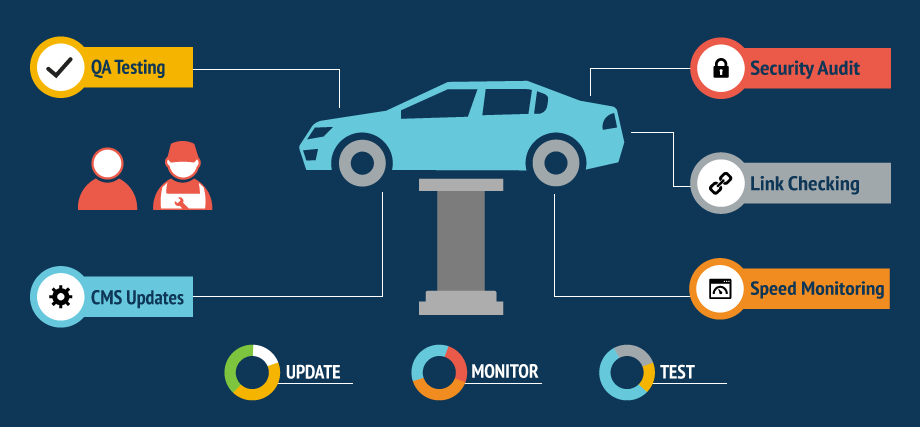At Red Letter Marketing, we specialize in helping our clients get the right website for their needs. That might require building a new custom site, a templated site, or updating their existing site. But no matter what, we also know every site requires regular website maintenance, and we want you to understand why.
Website functionalities are constantly changing.
Many clients believe that once their site is built, it will function flawlessly forever. Sadly, there is no such thing (because if there was, we’d build only that). The fact is, websites need routine upkeep and adjustments, much like cars, to keep things running smoothly. The environment in which your site functions changes every day. That means your code and software require regular maintenance to keep pace.
In other words, it’s not the car that’s slowly changing, but the road. Essentially, you need to adjust your vehicle to the landscape –a landscape that, for better or worse, you’re constantly navigating. You wouldn’t dare take your heavy, bald-tired pickup down a rainy Seattle highway. But that same truck might be perfectly fine to drive 300 days a year in Arizona. Transfer that attitude to your site, and it seems obvious you’d want to keep everything safe and smooth.
Invest a little on regular website maintenance, or spend a lot to recover what you’ve lost.
Many people believe that a fresh site should never require care. That belief usually comes from comes from 1) the desire to save money, and 2) unfamiliarity with the way sites work. We can dismiss the first easily, using our car metaphor. Refusing to replace your wiper blades because your car still runs is absurd. However, driving has many other facets than a solid vehicle. There’s a user to consider, and if that user faces complications, your running engine is useless.
The latter is simply a matter of being unacquainted with site function. Most of the websites you use and visit every day –particularly those utilizing databases (like Google and Amazon)– contain countless lines of code, and rely on software that runs on your web host. Odds are, the code was written by several developers, with different skillsets, at different times. Much of this is “open source,” or code made available to the general public, completely free of charge. Needless to say, this code changes often and drastically, and results in malfunctions within your site. Then, pages load slower, and links break without warning. Finally, it’s a cybersecurity risk.
A cybersecurity breach can devastate your business.
It’s no secret that hackers (and other digital villains) threaten neglected sites by searching for vulnerabilities in code. If you’re even vaguely familiar with code, you know that, like Christmas lights, one glitch can cause the whole shebang to go dark. A site hack can have devastating fallout, and reinstalling from a backup won’t always cut it. If there was any data processed between the fallow and reinstall, you’ll likely lose it to the ether. For businesses that can mean lost leads, or, in the ecommerce world, missing orders.
Then, you will need to understand and address exactly how hackers exploited your site in order to stop it from happening again. That means fixing existing damage and upgrading the code (and themes, and extensions) to run the latest software. Finally, these fixes don’t come cheap; repairs can cost ten times what website maintenance would. Put that on top of the revenue lost during downtime, and you’re looking at a hefty bill.
Regular website maintenance assures smooth and secure operations for both you and your site’s visitors. Without it, things will start to chip away –and that’s if nothing bad happens. At its worst, unmaintained sites get exploited through outdated source code, bringing down the castle walls.
Users expect everything on a website to function predictably, and they will quickly leave if it’s not working as expected.
To keep everyone happy, and your business well represented, get that oil changed methodically, and adjust your equipment to the road. Invest in website maintenance.






